 Research Article
Research Article
International vs. U.S. Dental Residents’ Stress, Experienced Discrimination, Subjective Well-Being and Depression: A National Survey
Majed Khalid Almadani1, Joseph D Dennison2, Robert A Bagramian3, Tracy L de Peralta4 and Marita R Inglehart5*
1Restorative Implantologist in Riyadh, Saudi Arabia
2Professor Emeritus of Dentistry, Department of Cariology, Restorative Sciences, and Endodontics, University of Michigan-School of Dentistry, Ann Arbor, MI, USA
3Professor of Dentistry, retired from the Department of Periodontics and Oral Medicine, University of Michigan-School of Dentistry, Ann Arbor, MI, USA
4Senior Associate Dean of Academic Affairs and Innovation, University of Colorado, Anschutz Medical Campus, School of Dental Medicine, Aurora, CO, USA
5University Diversity and Social Transformation Professor, Professor of Dentistry, Department of Periodontics and Oral Medicine, School of Dentistry & Adjunct Professor of Psychology, Department of Psychology, College of Literature, Science & Arts (LSA), University of Michigan, Ann Arbor, MI, USA
Marita R Inglehart, University Diversity and Social Transformation Professor, Professor of Dentistry, Department of Periodontics and Oral Medicine, School of Dentistry & Adjunct Professor of Psychology, Department of Psychology, College of Literature, Science & Arts (LSA), University of Michigan, Ann Arbor, MI, USA.
Received Date: August 07, 2023; Published Date: September 05, 2023
Abstract
Objective: Graduate dentistry programs in the United States (U.S.) enroll large numbers of international residents. The objectives were to compare (a) dental environment-related stress and experienced discrimination of international vs. in- and out-of-state U.S. dental graduate students, (b) their well-being and depression scores, and (c) the relationships between stress and mental health for these two groups.
Methods: Ninety-four international graduate students from 26 countries and 142 in- and out-of-state dental residents in U.S. dental graduate programs responded to anonymous web-based surveys.
Results: Compared to in-/out-of-state dental residents, international residents reported more stress related to faculty and administrator interactions (4-point scale with 1=not at all stressful: 2.01 vs. 2.25; p=0.015), work-related self-confidence (2.08 vs.2.29; p=0.027), work-life balance (2.19 vs. 2.51; p=0.005), and social interactions (1.76 vs. 1.97; p=0.014). International residents experienced more frequently negative treatment from peers, faculty and staff because of their ethnic/cultural background (5-point scale with 5=very often: 1.64 vs. 1.18; p<0.001) than U.S. residents. They had less positive subjective well-being (5-point scale: 3.24 vs. 3.41; p=0.005) and higher mean depression scores (3-point scale: 1.72 vs. 1.56; p=0.002) than their in-/out-of-state peers. Stress correlated with well-being and depression for each group. Discrimination scores only correlated with international residents’ depression scores (r=0.41; p<0.001).
Conclusion: International students in dental graduate programs in the U.S. experience higher stress, more discrimination, lower subjective well-being and more depression than U.S. residents. These findings should alert dental graduate program administrators to consider how to support international residents more optimally.
Keywords:MeSH terms: Students; Dental; Depression; Occupational stress; Stress, psychological; Internship and Residency Other keywords: Dental graduate programs; Discrimination; International students; Dental residents; Physical well-being; Post graduate students
Introduction
Stress of pre-doctoral dental students has been widely studied over the past decades [1, 2]. In comparison, stress of students in dental graduate programs received much less attention, especially in the United States (U.S.). Research in other countries such as in Greece [3], Spain [4], Switzerland [5], the United Kingdom [6] and India [7] documented consistently that residents in dental graduate programs experienced substantial degrees of stress.
This situation is likely to be exacerbated for international students in dental graduate programs because being an international student brings additional and unique stress with it [8, 9]. However, no research so far focused on stress of dental residents in the U.S., and specifically on the stress experienced by international dental residents in these programs. This situation is unfortunate because international dental residents are at the junction of three stressors. First, as healthcare professionals, dental residents often perform under stressful conditions [10]. Second, they are in a challenging and stressful educational situation [3-7] and third, face the stress of acculturation [8, 9]. One way to gain a better understanding of international dental residents’ stress is to benchmark it against the stress of in- and out-of-state dental residents. This study, therefore, compared stress of in- and out-of-state dental residents with stress of international dental residents in the U.S.
Two types of stress are of specific interest when considering this group of students, namely first the stress caused by the dental education environment, and second, stress caused by experiences of negative treatment by others/discrimination. The first type of stress can be assessed with a questionnaire developed by Divaris, et al. [3, 5]. This instrument was based on the Dental Environment Stress (DES) questionnaire that was originally designed by Garbee, et al. [11] and Grandy, et al. [12] in the early 1980s to measure stress of dental students. Divaris, et al. first used this scale to assess dental students’ stress [13, 14], but then modified it to make it applicable to measure dental residents’ stress. They called this revised instrument the “Revised Graduate Dental Environment Stress” questionnaire (RGDES-32) [3, 5]. It is uniquely useful when assessing residents’ dental environmental stress and was therefore used in this research.
The second type of stress of interest was stress due to the residents’ negative experiences/discrimination by faculty, staff, peers, patients and persons outside of the program. A scale previously used in a study with dental students and students in internationally trained dentist programs (ITDP) asked how frequently the residents had been discriminated by these five person groups because of their ethnic and cultural background and because of their language fluency or lack thereof. Based on previous research concerning the relationships between experiencing discrimination and psychological distress [15], correlations between the residents’ scores on the two included scales were expected.
Concerning the consequences of experiencing stress, research with dental students showed the multitude of ways that stress affected these students’ lives. Quite a number of studies found that stress affected academic performance [16, 17], mental health such as causing depression [18, 19] and anxiety [20], and even life style related behaviors such as smoking [21] and drug abuse [22]. The question then arises whether dental residents’-and especially international dental residents’-degree of stress is also related to poorer psychological well-being [23] and increased depression scores [24].
In summary, the objectives of this study were to compare
a) dental environment-related stress and experienced discrimination and
b) well-being and depression scores of international vs. inand out-of-state dental graduate students in the U.S., and
c) to explore the relationships between these constructs of interest for each group.
Methods
This study was determined to be exempt from Institutional Review Board (IRB) oversight by the Health Sciences and Behavioral Sciences IRB at the University of Michigan, Ann Arbor, MI., on December 17, 2018 (#HUM00156888) because the data were anonymous. This research used a quasi-experimental study design, comparing responses of international dental residents with those of in- and out-of-state dental graduate students in the U.S.
Respondents: Ninety-four international dental residents and 142 in- and out-of-state dental graduate students in the U.S. responded to an anonymous survey.
Procedure: A list with emails of directors of dental graduate programs in the U.S. was compiled based on information posted on program websites. A recruitment email was sent to these program directors, informing them about the research and asking them to forward an attached email to their residents. The email for the residents informed them about the project and asked them to volunteer to respond to an anonymous survey that they could access by using a web link provided in the email.
Materials: The recruitment email was written according to the guidelines of the University of Michigan Health Sciences and Behavioral Sciences IRB. The survey consisted of five parts. Part 1 inquired about the respondents’ background and educational characteristics (see Table 1). Part 2 assessed the participants’ dental environment-related stress experiences with the Revised Graduate Environmental Stress Scale (RGDES-32) [3, 5]. It assesses stress caused by academic factors as well as by clinical engagement. It has 32 items and uses a 4-point answer scale ranging from 1 = “not stressful at all”, 2 = “somewhat”, 3 = “quite” to 4 = “very stressful”. (see Table 2 for the wording of the statements included).
Table 1:Background and educational characteristics of in-state and out-of-state vs. international dental graduate students.
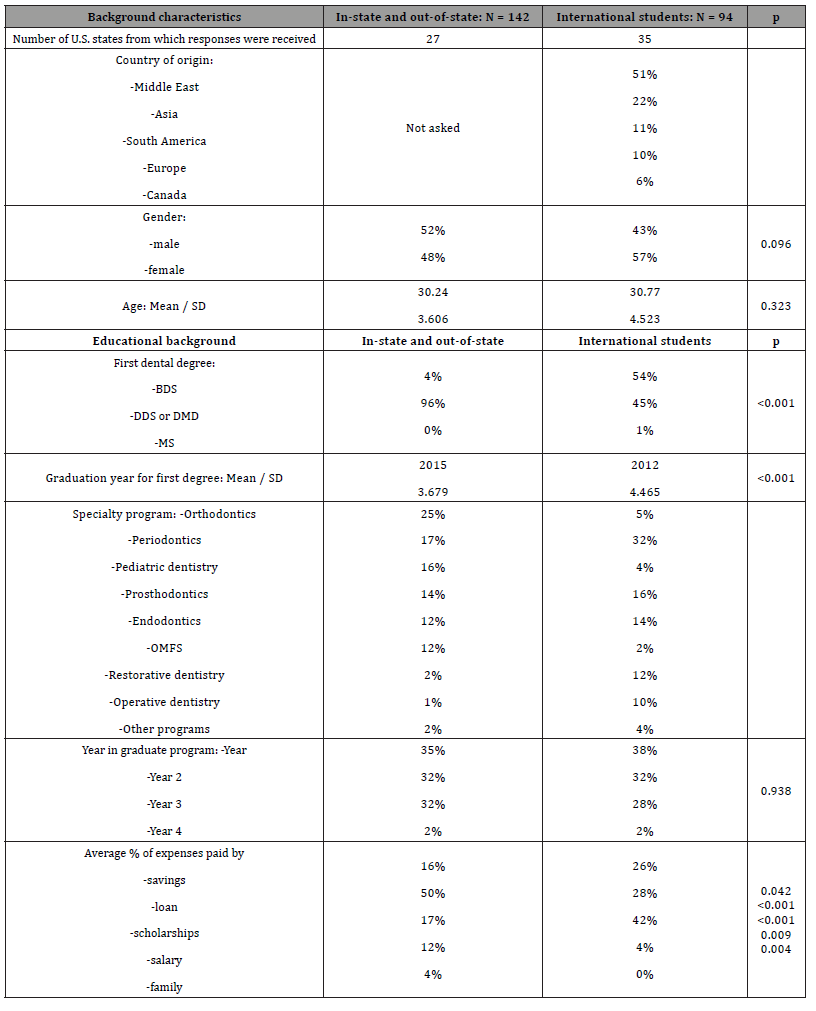
Table 2:In-state and out-of-state vs. international dental residents’ mean responses to the Revised Graduate Dental Environment Stress questionnaire (RGDES-32).
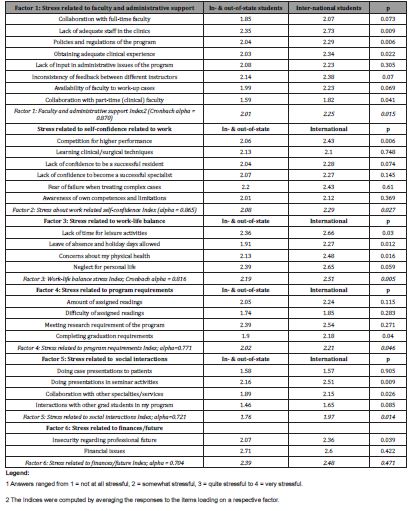
The second type of stress was stress due to perceived/ experienced discrimination. It was assessed with a scale that had been developed by the senior author (MRI) in a prior so far unpublished study with dental and internationally trained dentist program (ITDP) students. This scale consists of 15 questions with a 5-point answer scale format ranging from 1 = “never” to 5 = very often”. It asks the respondents to indicate how frequently they had experienced “negative treatment” by five groups of persons (faculty, staff, peers, patients and persons outside of the program) because of
(a) their ethnic background,
(b) their cultural background and
(c) their language proficiency (see Table 3).
Depression was measured with the Center for Epidemiological Studies Depression Scale [25] (see Table 4) and subjective wellbeing with Bradburn’s Affect Balance Scale (see Table 5) [26].
Table 3:Average responses (SD) related to negative treatment of in-state/out-of-state vs. international students.
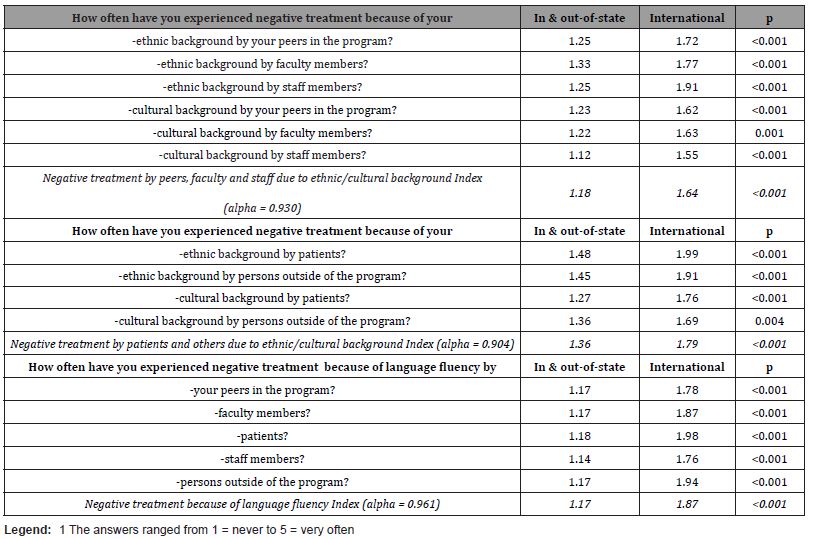
Table 4:In- and out-of-state vs. international residents’ average responses to the Subjective Well-being Scale.
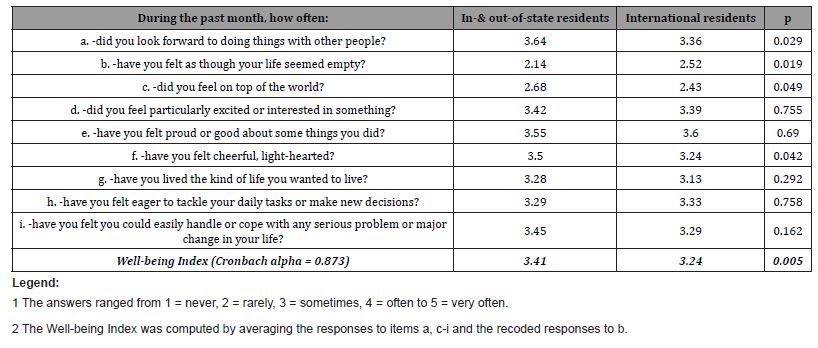
Table 5:Average responses to the Center for Epidemiological Studies Depression Scale by in- & out-of-state vs. international residents
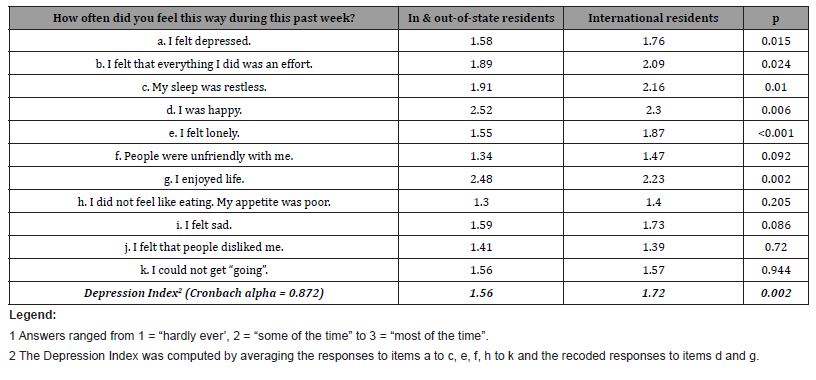
Statistical analyses: The data were downloaded from Qualtrics and imported into SPSS (Version 26). Descriptive statistics such as percentages and means were computed to provide an overview of the responses. Independent sample t-tests were used to compare the means of the two groups.
Four factor analyses were computed to determine the underlying factors of
(a) the dental environment-related stress items,
(b) perceived discrimination-related items,
(c) depression items and
(d) subjective well-being items (Extraction Method: Principle Component Analysis; Rotation Method: Varimax Rotation with Kaiser Normalization).
The factor analysis of the responses to the dental environmentrelated stress items had a six factor solution. Table 2 shows which items loaded on each of the five factors. The inter-item consistency of all five sets of items was good with Cronbach alpha values all greater 0.70 [27]. The factor analysis with the responses to the experienced discrimination items had a three factor solution, Table 3 shows which items loaded on each of the three factors. The Cronbach alpha inter-item consistency coefficients showed that each of the three sets of items had excellent inter-item reliability, with alphas greater than 0.90 [27]. The responses to all items of the Subjective Well-being Scale loaded on one factor (see Table 4) (Cronbach alpha = 0.873); the responses to the CESD scale items also loaded on one factor (see Table 5) (Cronbach alpha = 0.872).
Indices were computed by averaging the responses to each group of items loading on one factor respectively. These indices were used when Pearson correlation coefficients were computed to determine the relationships between stress, well-being and depression. A statistical significance of p<0.05 was accepted for the group comparisons.
Results
Table 1 provides an overview of the background characteristics of the 142 in- and out-of-state vs. 94 international graduate dental students who participated in this research. Both groups came from graduate dental programs in a large number of different U.S. states (in- and out-of-state residents: N=27; international residents: N=35). About half of the international respondents came from the Middle East (51%), with others coming from countries in Asia (22%), South America (11%) and Europe (6%). The gender distribution of the respondents did not differ between the two groups, with slightly more international residents being female (57%) and slightly more of their U.S. peers being male (52%). Both groups were on average between 30 and 31 years old.
Concerning the educational background of the international students, the majority had a bachelor dental degree (BDS: 54%), while the absolute majority (96%) of the U.S. residents had a DDS or DMD degree. Residents in both groups attended nine different types of specialty programs and had about equal representations of students in years one to three of their program. While half of the U.S. residents financed their education with loans, only 28% of the international residents took out loans. International respondents were more likely to receive scholarships (42%) and pay from their savings (26%) than their U.S. peers (17% / 16%).
Twenty-eight of the 32 items of the RGDES-32 questionnaire were included in this study. A factor analysis (Extraction Method: Principle Component Analysis; Rotation Method: Varimax Rotation with Kaiser Normalization) showed that these items loaded on six factors (see Table 2). A comparison of the two groups’ mean indices for these six stress areas showed that international students had significantly more stress in five of the six stress domains than their U.S. peers. They reported that their stress due to a lack of faculty and administrative support was between “somewhat” and “quite stressful”, while their peers reported a stress level closer to “somewhat stressful” (4-point scale with 1 = not at all, 2 = somewhat, 3 = quite to 4 = very stressful: 2.51vs. 2.19; p=0.046). The international residents reported more stress due to a lack of adequate staff in the clinics (2.73 vs. 2.35; p= 0.009), due to polices and regulations of the program (2.29 vs.2.04; p=0.006), due to obtaining adequate clinical experiences (2.34 vs. 2.03; p=0.022), and due to collaboration with part time faculty (1.82 vs. 1.59; p =0.041) than their U.S. peers. In comparison to the U.S. residents, they also reported more overall stress related to their work-related self-confidence (2.29 vs. 2.08; p=0.027), their work-life balance (2.51 vs. 2.19; p=0.005), their program requirements (2.21 vs.2.02; p=0.046) and their social interactions (1.97 vs. 1.76; p=0.014). Analyzing which significant differences were found for specific items in each of these groups of items can be quite informative.
Table 2 also shows that the two resident groups did not differ significantly in their mean stress related to Factor 6: “Stress related to finances/future” Index (2.48 vs. 2.39; p=0.471). While both groups were somewhat to quite stressed by financial issues (2.60 vs. 2.71; p=0.422), international residents were more stressed by being insecure about their professional future (2.36 vs. 2.07; p=0.039) than in- and out-of-state students.
Table 3 provides an overview of the average responses related to how frequently international vs. in- and out-of-state dental residents experienced negative treatment due to their ethnic or cultural background or their language fluency. The 15 items of this scale loaded on three factors. The first factor can be described as the frequency of being treated negatively due to one’s ethnic and cultural background by peers, faculty and staff members. While the mean responses of the in- and out-of-state residents were close to an answer of “never”, the international residents’ mean responses were consistently higher, both for the overall index response (5-point scale with 1=never: 1.18 vs. 1.64; p<0.001) as well as for each of the six specific items loading on this factor.
The same pattern of results was found for the responses to the items loading on the second and third factor. The average responses to an index concerned with the “Frequency of being negatively treated by patients and persons outside of the program” (1.36 vs. 1.79; p<0.001) (= Factor 2) and to an index concerned with the “Frequency of negative treatment by all five groups of persons” (1.17 vs. 1.87; p<0.001) (= Factor 3) showed that while these responses were overall quite infrequent, international residents were exposed to them significantly more frequently than in- and out-of-state residents.
Two variables were considered as potentially being affected by stress and by discrimination, namely subjective well-being (see Table 4) and depression (see Table 5). In- and out-of-state residents had overall a significantly more positive mean subjective well-being than international residents (5-point scales with 1= most negative response: 3.41 vs. 3.24; p=0.005). Specifically, international respondents were less frequently looking forward to doing things with other people (3.36 vs. 3.64; p=0.029), and felt more frequently that their life seemed empty (2.52 vs. 2.14; p=0.019) than their U.S. peers.
Concerning the depression related responses, Table 5 shows that international residents had higher mean depression scores than their peers (3-point scale with 1= most positive response: 1.72 vs. 1.56; p=0.002).
Table 6 provides an overview of the relationship between stress and experienced discrimination on one hand and average well-being and depression scores on the other hand. Because the number of significance tests in this table was high, a Bonferroni correction was used and only p-values <0.001 will be considered [28]. Pearson correlation coefficients showed that the in- and outof- state residents’ depression scores correlated with each of the six graduate dental environmental stress indices and that their subjective well-being index correlate with all but one of these six stress indices. However, their experienced discrimination indices did not correlate with their subjective well-being index and only the experienced ethnic and cultural discrimination by patients and persons outside of the program correlated with their depression scores.
Table 6:Correlations between mean stress and experienced discrimination scores and mean well-being and depression scores
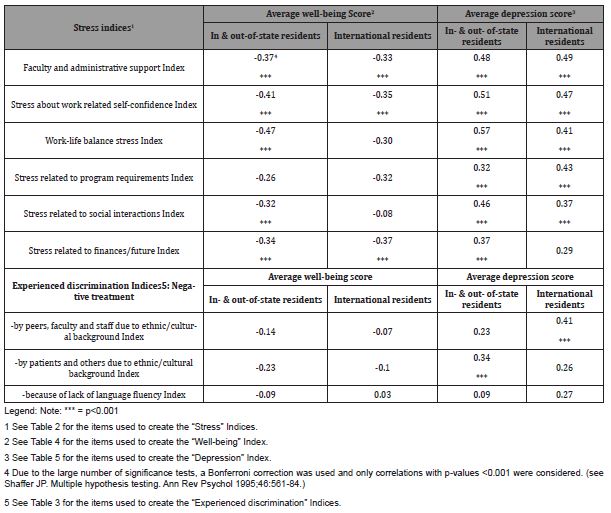
The international residents’ subjective well-being scores correlated with three of the six stress indicators and none of the three indicators of experienced discrimination. The more stress they had related to lack of faculty and administrative support (r=- 0.37; p<0.001)), work-related self-confidence (r=-0.35; p<0.001) and financial/future concerns (r=-0.37; p<0.001), the less positive was their subjective well-being.
However, five of the six environmental stress indices correlated with the international students’ mean depression scores. In addition, the more frequently they had experienced negative treatment by peers, faculty and staff members, the higher their depression scores were (r=0.41; p<0.001).
Discussion
In June 2019, the Health Policy Institute of the American Dental Association published the report “2018-19 Survey of Advanced Dental Education” [29]. Table 4 of this report shows that in the academic year 2018-19 when these data were collected, 7,318 residents were enrolled in these programs, with 440 (6%) being nonresident aliens. Receiving responses from 94 international residents would indicate a 21.34% response rate for the international resident group. Such a response rate to a web-based survey is substantial [30]. While the response rate of the in- and out-of-state residents is considerably lower, its sample size is sufficient to conduct the comparisons of interest between these two groups. In addition, the fact that these residents represented nine different types of dental graduate programs and that they came from all years of these graduate programs is encouraging as well. In conclusion, the numbers and types of respondents in this quasiexperimental study allowed exploring the hypotheses of interest.
The first construct of interest was stress related to the graduate dental education environment. The data showed that-as predicted-international residents in U.S. graduate dental programs reported on average more stress in five of the six content areas in the academic stress domain compared to their in- and out-ofstate peers. Specifically, the first area was stress related to a lack of faculty and administrative support. International students had more stress due to a lack of adequate staff in the clinics, because of program polices and regulations, due to concerns about obtaining adequate clinical experiences and due to problems in collaboration with part-time clinical faculty. These findings are supported by results from research with graduate students in other countries who also reported stress due to administrative issues and clinical and staff concerns [3, 5-7]. The international residents also reported significantly more stress due to their self-confidence related to work than their U.S. peers. Again, findings from research concerning pre-doctoral dental students’ stress [1, 2] and stress of graduate dental students in other countries [3-7] are consistent with these concerns. In addition, they experienced more stress related to program requirements such as the amount of assigned readings, difficulty of assigned readings and completing graduation requirements than their U.S. peers. This finding is also supported by other research such as the study by Shetty, et al. [7] who also found significant stress among students due to program requirements [7].
When interpreting these findings, one academic and one personal factor could potentially moderate these findings. The academic factor is concerned with the international students’ academic background prior to coming to the dental graduate program. One could argue that the 54% of the international residents with a Bachelor of Dental Science (BDS) degree might experience more stress than the 46% who enrolled with a DDS/DMD or MS degree in a dental graduate program. However, comparisons of the average stress and perceived discrimination indices as well as the average well-being and depression scores showed that these two groups of international residents did not differ significantly in any of these indices. A personal moderating factor could be whether these international residents came with vs. without their families to the U.S. The data showed that 57 international residents lived alone and 35 with their families. One could argue that residents living with their families might have the social support at home that helps them to cope better with stress. However, comparisons of the average stress, perceived discrimination, well-being and depression indices showed that the two groups did not differ significantly in any of these indices. The findings that neither the international residents’ academic background nor their personal living situations made a difference in the degree to which these students reported stress and experienced discrimination is quite relevant because it underlines the power of being an international resident in these students’ lives.
In summary, these findings clearly showed that international residents indeed do experience more stress due to their graduate dental school environment than their peers. These results are supported by findings from studies with dental students in the U.S. and with graduate students in other countries. However, the true value of these findings lies in the fact that they allow concrete insights into which specific aspects of the graduate dental education environments are specifically stressful for international students and should be addressed. Gaining a better understanding of these aspects can guide efforts for educational interventions aimed at optimizing the environment to allow the best possible educational outcomes and/or to support international students in coping with these challenges. For example, having specific orientation sessions for international dental residents when they arrive on campus that support them with their administrative requirements, help them understand cross-cultural communication differences in verbal and nonverbal communications and cultural norms related to interactions between male and female dentists and patients and patients from different economic, racial/ethnic and LGBTQ+ backgrounds could contribute to avoiding cross-0cultural communication breakdowns. In addition, providing faculty development workshops about the role of cultural differences in instructor-resident and patient-provider interactions could also be quite beneficial.
The second type of stress was concerned with the frequencies of negative treatment by peers, faculty, staff, patients and persons from outside the program due to ethnic and cultural background and language characteristics. The finding that international students consistently reported more frequent negative treatment by all groups deserves attention not only because it is unethical, but also because previous research showed the negative effect of being discriminated on academic achievement and grades [31, 32]. Developing educational interventions for faculty and staff members to educate them about how to avoid cross cultural communication break downs and offer an inclusive teaching environment could be an important way to improve the situation for international residents as well as for residents from underrepresented minority backgrounds or other stigmatized groups [33].
This study was a first step in exploring the international residents’ stress-related experiences. The two types of stress considered in this study were included because they appeared to be uniquely relevant for international dental residents. Their impact on these residents’ lives might be far reaching. In addition, this study also focused on two potential outcomes, namely how this stress affects the students’ quality of life/subjective well-being and their mental health, specifically depression. The results showed that the international students had lower subjective-well-being than in- and out-of-state residents and higher depression scores. These findings need to be discussed in the context of research related to the level of depression among dental students. For example, research with dental students in Australia [34] showed that dental students had higher levels of depression, anxiety or stress than the general population. Gaining a better understanding of the interplay of stress and depression in this context is important. Specifically, the finding that more frequent negative treatment by peers, staff and faculty due to the international students’ ethnic and cultural background correlated with higher depression scores deserves attention. Having students from diverse backgrounds in an educational setting that educates future health care providers provides excellent opportunities for developing interpersonal skills related to communicating with patients and their families from diverse backgrounds. Integrating educational interventions into graduate dental program curricula concerning cross-cultural communication could not only support international residents’ acculturation, but could also increase graduates cultural competency in relation to communicating with patients and providing culturally appropriate care.
Limitations: This study has several limitations. First, concerning the data collection, it is possible that the name of the first author who recruited graduate students into this study motivated students from his national background or area of the world to be more likely to respond to this survey. Future research should avoid such a potential bias. Second, while the sample size was sufficient to compare the responses of the two groups, it was too small to do subgroup analyses such as to compare the responses of students from Middle Eastern countries with those of students from other parts of the world. Future research should find ways to increase the sample size to allow subgroup analyses. Third, one interesting question could be if the term stress might be interpreted equally b\y Native and Non-native English speakers. Offering the surveys in the international residents’ native language in future studies could provide insights into this question. Fourth, while the size of the correlations was substantial for social science research, one might argue that some significant differences were not of a substantial size. However, it seems important to understand in which content areas efforts are needed to level the playing field for international and domestic residents-even if the differences are small. Finally, the potential consequences of stress studied in this research were subjective well-being and depression. Other outcomes such as the ways that stress might affect international residents’ academic and clinical performance should be explored in future research. This was the first study of stress in international graduate dental students in the U.S. and we hope that research will continue to investigate this topic to allow gaining a better understanding of the ways dental graduate programs in the U.S. could be changed to provide a more optimal learning environment for all students.
Conclusion
Based on these findings, it can be concluded that international residents in dental graduate programs in the U.S. indeed experience significantly more stress related to the graduate dental environment than their in- and out-of-state peers. The results allow analyzing the specific stressors in this context and thus provide a basis for designing educational and administrative interventions aimed at reducing stress for these students.
In addition, it can be concluded that international residents more frequently experience negative treatment by their peers, faculty and staff members as well as by patients and persons outside of the programs due to their ethnic and cultural background and their language skills than their U.S. peers. This finding should alert program administrators to develop faculty and staff training to increase cultural competency and to decrease communication breakdowns between international residents and their supervising faculty members and supporting staff members.
The findings also show that international residents’ quality of life/subjective well-being and their mental health, specifically their depression scores, were significantly less positive than those of their peers. Association between graduate dental environment stress and well-being as well as depression show the importance of gaining a better understanding of how to improve environmental factors that can prevent residents from living up to their potential and having the best possible educational experiences as guests in the U.S.
Acknowledgements
We want to thank the dental residents who took time out of their busy schedules to respond to this survey. We could not have done this research without your support. We also want to thank the two reviewers of the manuscript for their insightful and helpful comments.
Conflict of Interest
No Conflict of interest.
References
- Bossch L Vanden, Vanderstraeten G (2005) Heterotopic ossification: A review. J Rehabil Med 37(3): 129-136.
- Ranganathan K, Loder S, Agarwal S, Wong VW, Forsberg J, et al. (2014) Heterotopic ossification: Basic-science principles and clinical correlates. J Bone Joint Surg Am 97(13): 1101-1111.
- Jihad Salman N, dos Santos Trento G, Henrique de Azambuja Carvalho P, Aparecida Cabrini Gabrielli M, Francisco Real Gabrielli M, et al. (2021) Heterotopic Ossification Around Temporomandibular Joint Prosthesis: Research Article and a Scoping Review.
- Lee YW, You HJ, Jung JA, Kim DW (2018) Mandibular reconstruction using customized three-dimensional titanium implant. Arch Craniofac Surg 19(2): 152-156.
- Ringold S, Thapa M, Shaw EA, Wallace CA (2011) Heterotopic ossification of the temporomandibular joint in juvenile idiopathic arthritis. J Rheumatol 38(7): 1423-1428.
- Al Moraissi EA, Dahan AA, Alwadeai MS, Oginni, FO, Al Jamali, JM, et al. (2017) What surgical treatment has the lowest recurrence rate following the management of keratocystic odontogenic tumor?: A large systematic review and meta-analysis. Journal of Cranio-Maxillofacial Surgery 45(1): 131-144.
- Guarda Nardini L, Manfredini D, Olivo M, Ferronato G (2014) Long-Term Symptoms Onset and Heterotopic Bone Formation around a Total Temporomandibular Joint Prosthesis: a Research Article. J Oral Maxillofac Res 5(1).
- Selbong U, Rashidi R, Sidebottom A (2016) Management of recurrent heterotopic ossification around total alloplastic temporomandibular joint replacement. Int J Oral Maxillofac Surg 45(10): 1234-1236.
- Qassemyar Q, Assouly N, Temam S, Kolb F (2017) Use of a three-dimensional custom-made porous titanium prosthesis for mandibular body reconstruction. Int J Oral Maxillofac Surg 46(10): 1248-1251.
-
Majed Khalid Almadani, Joseph D Dennison, Robert A Bagramian, Tracy L de Peralta and Marita R Inglehart*. International vs. U.S. Dental Residents’ Stress, Experienced Discrimination, Subjective Well-Being and Depression: A National Survey. On J Dent & Oral Health. 7(2): 2023. OJDOH.MS.ID.000657.
-
Dental education, Dental environment stress, Dental students, Dental graduate programs, Dental environment, Depression, Dental residents, Dental school, Dental Science, Dental graduate program
-

This work is licensed under a Creative Commons Attribution-NonCommercial 4.0 International License.






